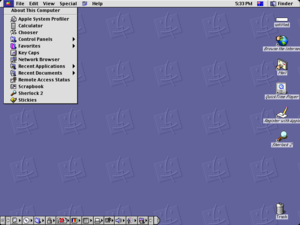Mac OS 9.2
| A version of the classic Mac OS operating system | |

Screenshot of Mac OS 9.
|
|
| Developer | Apple Computer, Inc., later renamed Apple Inc. |
|---|---|
| OS family | Macintosh |
| Working state | Historic, not supported |
| Source model | Closed source |
| Released to manufacturing |
October 23, 1999 |
| Latest release | 9.2.2 / December 5, 2001 |
| Kernel type | Nanokernel |
| License | Proprietary |
| Preceded by | Mac OS 8 |
| Succeeded by | Mac OS X Public Beta |
| Official website | Apple - Products - Mac OS 9 at the Wayback Machine (archived November 9, 2000) |
| Support status | |
| Unsupported as of February 1, 2002 | |
Mac OS 9 is the ninth and final major release of Apple's classic Mac OS operating system. Introduced on October 23, 1999, it was promoted by Apple as "The Best Internet Operating System Ever", highlighting Sherlock 2's Internet search capabilities, integration with Apple's free online services known as iTools and improved Open Transport networking. While Mac OS 9 lacks protected memory and full pre-emptive multitasking, lasting improvements include the introduction of an automated Software Update engine and support for multiple users.
Apple discontinued development of Mac OS 9 in 2001, transitioning all future development to Mac OS X. Since that time, no updates have been released. The final updates to Mac OS 9 addressed compatibility issues with Mac OS X while running in the Classic Environment and compatibility with Carbon applications. At the 2002 World Wide Developers Conference, Steve Jobs began his keynote address by staging a mock funeral for OS 9.
Apple billed Mac OS 9 as including "50 New Features" and heavily marketed its Sherlock 2 software, which introduced a 'channels' feature for searching different online resources and introduced a QuickTime-like metallic appearance. Mac OS 9 also featured integrated support for Apple’s suite of Internet services known as iTools (later re-branded as .Mac, then MobileMe, which was replaced by iCloud) and included improved TCP/IP functionality with Open Transport 2.5.
...
Wikipedia
